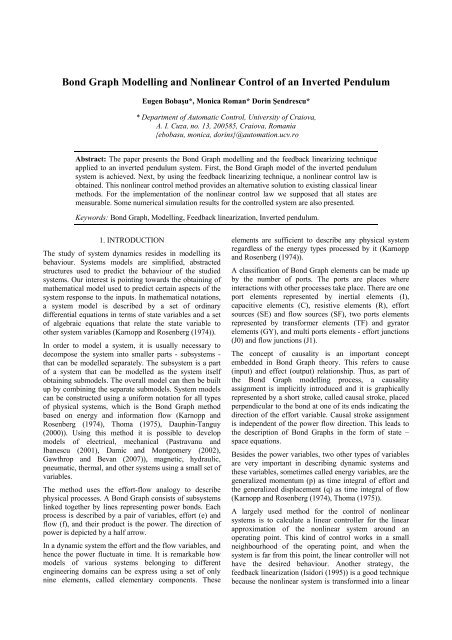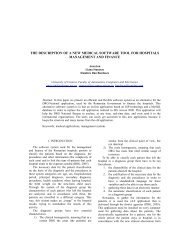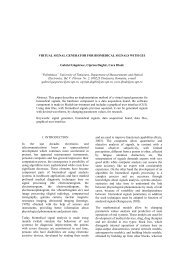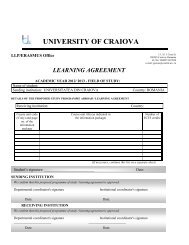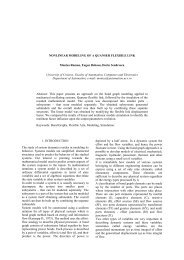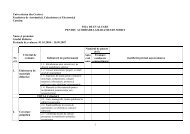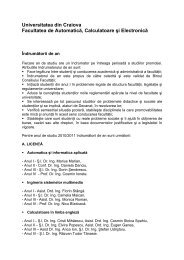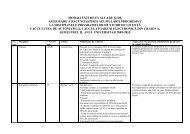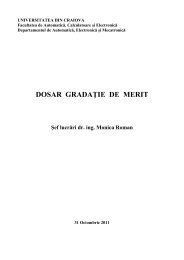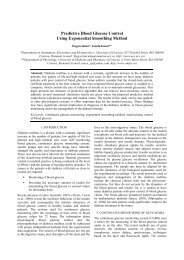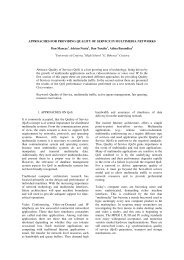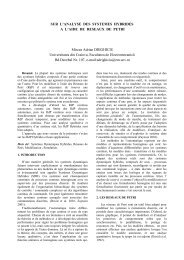Bond Graph Modelling and Nonlinear Control of an Inverted Pendulum
Bond Graph Modelling and Nonlinear Control of an Inverted Pendulum
Bond Graph Modelling and Nonlinear Control of an Inverted Pendulum
You also want an ePaper? Increase the reach of your titles
YUMPU automatically turns print PDFs into web optimized ePapers that Google loves.
⎡ 0 ⎤⎢ ⎥⎢0⎥⎢Cg( x)= − ⎥ , (7)⎢ E( x)⎥⎢ B cos x ⎥2⎢ ⎥⎣ E( x)⎦where we denoted:E2( x) B x − AC=22A = mr + J2 cos ,, B = mrl ,2C = ml , D = mgl .As the output variable, the <strong>an</strong>gular position α ( t)isconsidered:= h( x)= α() t = x () t(8)y24. THE FEEDBACK LINEARIZING METHODWe consider the following form <strong>of</strong> the state spaceequations in the case <strong>of</strong> nonlinear system:x&= f ( x)+ ∑ gi( x)uyj= h ( x)jmi=1j = 1... miwhere f ( x),g1(x),g2( x),...,gm( x)are smooth vectorfields (see Isidori (1995), Fossard <strong><strong>an</strong>d</strong> Norm<strong><strong>an</strong>d</strong>-Cyrot(1993)).The problem <strong>of</strong> exact linearization via feedback <strong><strong>an</strong>d</strong>diffeomorphism consists in tr<strong>an</strong>sforming a nonlinearsystem (9) into a linear one using a state feedback <strong><strong>an</strong>d</strong> acoordinate tr<strong>an</strong>sformation <strong>of</strong> the systems state.Let’s introduce now the Lie derivative <strong>of</strong> the functionh( x) : Rn → R along the vector fieldf ( x)= [ f1(x),...,f ( x)]:= ∂in∂= ∑n h(x)Lfh( x)fi( x)(10)i 1 xDefinition. A multivariable nonlinear system <strong>of</strong> the form0(9) has a relative degree r ,..., r } at a point x if:{ 1 mkLg jLfhi( x)= 0(11)for all 1 ≤ j ≤ m , for all 1 ≤ i ≤ m , for all k ≤ r i−1, <strong><strong>an</strong>d</strong>0for x in a neighbourhood <strong>of</strong> x , the m × m matrix:r1−1⎡ LgL h (x)1 f 1⎢ r2−1=⎢ LgL h (x)1 f 2A(x)⎢ .⎢r −1⎢⎣LgLfhm(x)1is nonsingular at........LLLr1−1g m fr2−1g mLfm 10x = x .g mL h ⎤1(x)⎥h2(x)⎥. ⎥⎥rm−Lfhm(x)⎥⎦(9)(12)Remark: Let be a SISO nonlinear system <strong>of</strong> the form (9),0which has the relative degree r at a point x .The state feedback:r[ − L h(x + v]1u =f)r− 1L L h(x)gftr<strong>an</strong>sforms the nonlinear system into a system, whoseinput-output behaviour is the same with a linear systemhaving the tr<strong>an</strong>sfer function:1H () s = .rsTheorem. Let be the nonlinear system <strong>of</strong> the form (9).Suppose the matrix g ( x0 ) has r<strong>an</strong>k m. Then the statespace exact linearization problem is solvable if <strong><strong>an</strong>d</strong> onlyif: for each 0 ≤ i ≤ n −1, the distribution G i has const<strong>an</strong>t0dimension near x ; the distribution Gn−1has dimensionn ; for each 0 ≤ i ≤ n − 2 , the distribution Giisinvolutive.For system (5) we have:LL0f2fhh0( x) = 0; L L h( x)( x)B=xg2 24fcos x2= 0; LE1 B cos x2L h =g fE( x)A( Bx3x4+ D)sin x2( x) −(13)Thus, we see that the system has relative degree r = 2 . Inthis situation, the state feedback:1 2u = ( −Lh(x)v)1 f+(14)L L h(x)gftr<strong>an</strong>sforms the system (5) into a system whose inputoutputbehavior is identical to that a linear system having1a tr<strong>an</strong>sfer function: H ( s)= .2sImposing on the linear system <strong>an</strong> additional feedback <strong>of</strong>the form:v = c (ref− c x&(15)0α − x2)12then, the obtained system has a linear input-outputbehavior, described by the following tr<strong>an</strong>sfer functionH ( s)c0= (16)2s + c1s+ c0In relation (15)deflection.αrefis the imposed reference <strong>of</strong> the armThe coefficients c 0, c1in (16) are determined using apole placement procedure. The values <strong>of</strong> thesecoefficients are chosen such that the behaviour <strong>of</strong> theentire closed loop system has a desired shape (Bobasu etal. (1998a)).
5. SIMULATION RESULTSIn order to test the behaviour <strong><strong>an</strong>d</strong> the perform<strong>an</strong>ce <strong>of</strong> theproposed nonlinear control strategy, extensive simulationswere performed using the Qu<strong>an</strong>ser <strong>Inverted</strong> <strong>Pendulum</strong>experiment.The values <strong>of</strong> the inverted pendulum parameters are:m = 0.128kg;r = 0.158m;l = 0.35 m;22J = 0.0015kgm ; g = 9.81m/sThe design parameters are set to:c0= 100 , c1= 14Fig. 5 presents the time evolution <strong>of</strong> the pendulum armdeflection α (in radi<strong>an</strong>s) for α ref= 0 .1.210.80.60.40.20[rad]Time [s]-0.20 0.5 1 1.5 2 2.5 3Fig. 5. Time evolution <strong>of</strong> pendulum arm deflectionIt c<strong>an</strong> be seen that the behaviour <strong>of</strong> the controlled systemis quite good, <strong><strong>an</strong>d</strong> the inverted pendulum is stabilized.In Fig. 6 the time pr<strong>of</strong>ile <strong>of</strong> the <strong>an</strong>gular velocity α& isshown.1[rad/s]0Time [s]-1-2-3-4-50 0.5 1 1.5 2 2.5 3Fig. 6. Time evolution <strong>of</strong> pendulum <strong>an</strong>gular velocity α&6. CONCLUSIONSIn this paper our interest was pointed towards the <strong>Bond</strong><strong>Graph</strong> modelling <strong><strong>an</strong>d</strong> the design <strong>of</strong> feedback linearizingtechnique for <strong>an</strong> <strong>Inverted</strong> <strong>Pendulum</strong> system.The <strong>Bond</strong> <strong>Graph</strong> model <strong>of</strong> the system was built up writingfirst the word <strong>Bond</strong> <strong>Graph</strong> containing words instead <strong>of</strong>st<strong><strong>an</strong>d</strong>ard symbols for the main components <strong><strong>an</strong>d</strong> bonds forpower <strong><strong>an</strong>d</strong> signal exch<strong>an</strong>ge, <strong><strong>an</strong>d</strong> then replacing words byst<strong><strong>an</strong>d</strong>ards elements which contain precise mathematical orfunctional relations. The system was decomposed intothree subsystems that were modelled separately. Byjoining together these three models, we obtained thecomplete <strong>Bond</strong> <strong>Graph</strong> model <strong>of</strong> the Qu<strong>an</strong>ser Rotary<strong>Inverted</strong> <strong>Pendulum</strong> system. The model was created <strong><strong>an</strong>d</strong>simulated using 20sim modelling <strong><strong>an</strong>d</strong> simulationenvironment.The nonlinear control method based on the feedbacklinearizing technique provides <strong>an</strong> alternative solution toexisting classical linear methods. The implementation <strong>of</strong>the method requires a complete knowledge <strong>of</strong> the statevariables (or the use <strong>of</strong> a state observer).REFERENCESKarnopp, D., <strong><strong>an</strong>d</strong> Rosenberg, R. (1974). SystemDynamics: A Unified Approach. John Wiley, NewYork.Thoma, J. (1975). Introduction to <strong>Bond</strong> <strong>Graph</strong>s <strong><strong>an</strong>d</strong> TheirApplications. Perg. Press, Oxford.Dauphin-T<strong>an</strong>guy, G. (2000). Les <strong>Bond</strong> <strong>Graph</strong>s. HermesSci., Paris.Păstrăv<strong>an</strong>u, O., Ibănescu, R. (2001). <strong>Bond</strong>-graphl<strong>an</strong>guage in modeling <strong><strong>an</strong>d</strong> simulation <strong>of</strong> physicaltechnicalsystems. Gh. Asachi, Iasi.Damic, V., Montgomery, J. (2002). Mechatronics by<strong>Bond</strong> <strong>Graph</strong>s. Springer, Germ<strong>an</strong>y.Gawthrop, P.J., <strong><strong>an</strong>d</strong> Bev<strong>an</strong>, G.P. (2007). A TutorialIntroduction for <strong>Control</strong> Engineers. IEEE <strong>Control</strong>Systems, 27, 24-45.Isidori, A. (1995). <strong>Nonlinear</strong> control systems. Springer-Verlag, Berlin.Bobasu, E., Petre, E., Popescu, D. (1998). On nonlinearcontrol for electric induction motors. In Process<strong>Control</strong>'98, (1), 44-47. Pardubice, Czech Republic.Bobasu, E., Ionete, C., Seliste<strong>an</strong>u, D. (1998). Onnonlinear control for electric d.c. motors. In Process<strong>Control</strong>'98, (1), 42-46. Pardubice, Slovak Republic.Bodson, M., Chiasson, J., Novotnac R. (1994). High-Perform<strong>an</strong>ce Induction Motor <strong>Control</strong> Via Input-Output Linearization. IEEE Contr. Systems, 14 (4),25-33.Fossard, A.J., Norm<strong><strong>an</strong>d</strong>-Cyrot, D. (1993). Systemesnonlineaires. Masson, Paris.Raumer, T., Dion, J. M., Dugard, L., Thomas, J.L. (1994).Applied <strong>Nonlinear</strong> <strong>Control</strong> <strong>of</strong> <strong>an</strong> Induction MotorUsing Digital Signal Processing. IEEE Tr<strong>an</strong>s. Contr.Systems Technology, 2 (4), 327- 335.


